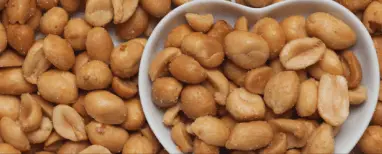
Activity in Portuguese proposes, to 2nd year high school students, the analysis of the employment of conjunctionlike, in the text dealing with the origin and expansion of “peanuts”.
This Portuguese language activity is available for download in an editable Word template, ready to print in PDF and also the completed activity.
Download this activity from:
SCHOOL: DATE:
PROF: CLASS:
NAME:
Read:
Peanuts (in Tupi, “Mani”, which means buried) is a popular food in all regions of Brazil, and can be consumed both sweet and savory. The seed is part of Brazilian culture, and is the main ingredient in many traditional recipes, such as paçoca, pé-de-moleque, cakes and even ice cream. Although its origin is not certain, there are reports that peanuts originated in South America.
Some experts believe that the legume was discovered in Brazil or that it emerged in the Gran Chaco region, located between Paraguay, northern Argentina and Peru. However, there are documents from 3800 a. Ç. to 2900 a. a., who affirm that the seed arose to the east of the Andes, where it was widely used by the natives.
Another piece of information that was lost in history is when peanuts began to be used. According to Evaristo Eduardo e Miranda, general head of EMBRAPA Satellite Monitoring, it was discovered and explored long before the current Indians emerged.
Researches show that, in a remote past, the Chinese were already great plant cultivators. Along these lines, very old craft works, such as clay pots and vases in the shape of peanuts, demonstrate that the South American peoples have also known the legume for a long time.
One more interesting fact is that peanuts were found in the tombs of the Incas, so that, following the belief, the dead could feed during the passage to "the other side".

Available in: http://www.abicab.org.br. Accessed on: June 25, 2016.
Question 1 - Check the alternative where the reference to peanuts is made using a pronominal form:
a) “[…] it is the main ingredient of many traditional recipes […]”.
b) “Although its origin is not certain […]”.
c) “Some experts believe that the legume was discovered in Brazil […]”.
d) “[…] the Chinese were already great cultivators of the plant.”.
Question 2 -The seed is part of Brazilian culture, and is the main ingredient of many traditional recipes, like paçoca, pe-de-moque, cakes and even ice cream. In this segment, the conjunction "how" introduces:
a) an example
b) an enumeration
c) a comparison
d) a suggestion
Question 3 - Identify another passage in the text, in which the conjunction "how" fulfills the purpose identified above:
Question 4 – Although, there are documents from 3800 to. Ç. to 2900 a. a., who affirm that the seed arose to the east of the Andes, where it was widely used by the natives. This period, through the highlighted conjunction, establishes with the previous period the relationship of:
a) addition
b) time
c) adversity
d) place
Question 5 - In the excerpt One more interesting fact is that peanuts were found in the tombs of the Incas, so that, following the belief, the dead could feed during the passage to "the other side", the quotation marks were placed for:
a) show a grammatically unacceptable form.
b) indicate a little-known way of speaking.
c) flag a quote by someone else.
d) highlight an expression used outside its usual context.
By Denyse Lage Fonseca – Graduated in Languages and specialist in distance education.
At answers are in the link above the header.
 report this ad
report this ad

